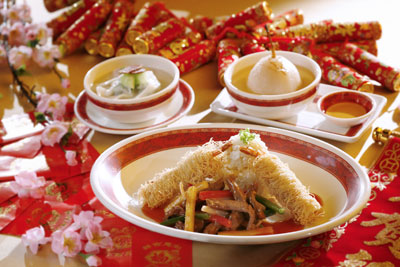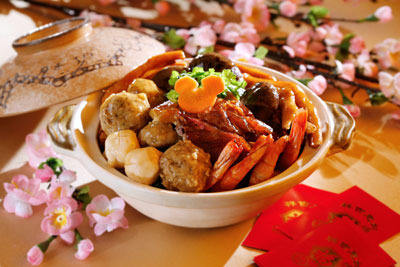|
After the reunion dinner on New Year's Eve, or Chuxi in Chinese, it is the New Year! The menu for the first meal of the New Year is not a thorny problem for us Chinese.In northern China, dumplings are always the main dish on the dining table, while, in southern China, there is a wide variety of choices in difference provinces.

South China's Hunan Province: For people of this province, Niangao, a sweet, sticky, brown cake, is a must Spring Festival treat for the first meal. In Chinese, Gao is a homonym for high. Niangao is also called Nian Nian Gao, which is a homonym for "higher each year," symbolizing progress and promotion at work as well as in daily life and improvement in life year by year.
Some of Hunan's ethnic minorities, such as the Miao people, have wine made from sweet fermented glutinous rice and pyramid-shaped dumplings made of glutinous rice wrapped in bamboo or reed leaves for their New Year's first meal.
Central China's Hubei Province: People of Tuanfeng County in this area usually have chicken soup, which symbolizes "auspiciousness and peace," as part of their New Year's first meal. Besides, there are chicken paws, which represent "seizing fortune in the new year" for the family's labor productivity, and chicken wings, symbolizing "soaring to great heights" for small schoolboys and girls.

In some places, such as Jingzhou and Shashi, eggs are an indispensable dish of the New Year's first meal. When a guest arrives, the host most likely treats him or her to a poached egg with tender yolk and semi-transparent egg white, which represents "gaining gold and silver."
East China's Jiangxi Province: People of this area living around Poyang Lake have dumplings and fish, which represent "money" and "a surplus year after year" respectively. Sometimes, sugar cubes, flowers and coins are stuffed in the dumplings, signaling "sweet life," "longevity and immortality," and "making a fortune in the new year" respectively.
South China's Guangdong Province: In some places of this province, people prepare enough food for the first three days of the new year at a time prior to the arrival of the New Year; the food is called "Wannianliang", which expresses their wish of "not having to worry about food in the days to come."
South China's Guangxi Zhuang Autonomous Region: The Zhuang Ethnic people of this region usually have sweet food as their New Year's first meal to express their hope that life in the new year will be sweet and satisfactory!
East China's Fujian Province: It is the tradition for South Min people in this area to have noodles for their New Year's first meal, while for people in the Zhangzhou belt, it is customary to eat sausage, preserved eggs, and ginger, which combined symbolizes a "more and more prosperous life."
Jiangzhe Belt (East China's Jiangsu and Zhejiang provinces): People in Jiangsu and Zhejiang provinces often have the assorted "Spring Dish" with celery, fragrant-flowered garlic, and bamboo shoots.
East China's Anhui Province: In some areas of this province, every one take a bite of carrot, namely "to bite the spring," which is said to be capable of preventing diseases and anything other unfortunate thing.
Central China's Henan Province: People in some places of Henan province cook dumplings and noodles in the same container, and then treat every one to a bowl of the food, referred to as "golden thread through silver ingot."
China's Taiwan Province: Taiwanese, especially the province's Gaoshan Ethnic people, usually eat longevity mustard, which is sometimes cooked together with vermicelli, signaling "longevity and immortality."
|


